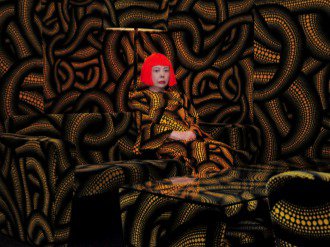Yayoi Kusama
dal 9/10/2011 al 8/1/2012
Segnalato da
9/10/2011
Yayoi Kusama
Centre Pompidou, Paris
The exhibition, curated by Chantal Beret, maps the key points in the artists career, illustrating the protean nature (painting, sculpture, performance, environments...) of a body of work the artist herself describes as ''obsessional''. This characteristic is strongly connected to a childhood memory, a hallucination that stands at the root of her recurrent motif of the dot. ''My life is a dot lost among thousands of other dots'', she has said.

curated by Chantal Béret
The Centre Pompidou is to stage the first French retrospective devoted to Japanese artist
Yayoi Kusama (born 1929): through a chronological display of some 150 works dating from 1949
to 2011, the exhibition pays tribute to an artist who stands apart, in a class of her own, yet
one who has had a considerable influence on contemporary art from Andy Warhol to Mike Kelley,
and who still attracts the interest of the rising generation.
The exhibition then travels to the Reina Sofia Museum, Madrid, Tate Modern, London, and
the Whitney Museum of American Art, New York. Each city will however make a distinctive
contribution to the whole, as the display will vary from place to place: the Centre Pompidou for
its part will put distinctive emphasis on Kusama’s sculpture and the experiments with colour
represented by her monochromes.
The exhibition maps the key points in the artists career, illustrating the protean nature (painting,
sculpture, performance, environments…) of a body of work the artist herself describes as
“obsessional.” This characteristic is strongly connected to a childhood memory, a hallucination
that stands at the root of her recurrent motif of the dot. “My life is a dot lost among thousands
of other dots,” she has said.
After an introductory section featuring her early, small-format works, notably a number of
watercolours never yet seen in Europe, marked by a certain Surrealist influence, the exhibition
falls into two major periods: exile in New York, and the return to Japan after 1973.
In collaboration with Tate Modern
Kusama’s whole work is organised in successive series
NEW YORK : 1958 -1973
INFINITY NETS SERIES:
Having arrived in New York in 1958, the artist produced her first monochrome white, large-format Infinity
Nets (sometimes reaching 11 m in length), an expression of her obsession with the infinite. In 1960 and
1961, she continued along on the same lines, but introducing colour (Infinity Nets Yellow, 1960, National
Gallery of Art, Washington)..
ACCUMULATIONS SERIES :
Kusama embarked on sculpture in 1961. Her textile sculptures are based on everyday objects picked up
in the streets of New York (a sofa for the first, Accumulation No. 1, then a table, chair etc.), on which she
clustered phallic forms in stuffed fabric. Aggregation: One Thousand Boats Show (1963, Stedelijk Museum,
Amsterdam) is her first installation, returning to the principle of accumulation but deploying it to create
an environment, images of a boat so treated being regularly repeated on the walls of the black box
in which it is installed. Also on display will be another key work of this period, My Flower Bed (1962), from
the Museum’s own collection.
HAPPENINGS AND PERFORMANCES :
In 1966, Kusama began to stage her first happenings, inside her environments Peep Show and Phalli’s
Field. Then came events in the New York streets, such as Walking Piece, 14th Street and the Anatomic
Explosion series. The politically and sexually transgressive New York scene of the years of Peace and
Love finds forceful expression in this element of her work.
JAPAN : 1973 - 2011
In 1973, Kusama returned definitively to Japan in a very fragile psychological state, the beginning
of a period whose darkness is illustrated by a number of collages (War, 1977; I Who Committed Suicide,
1977, Museum of Contemporary Art, Tokyo). In 1977, she decided to live in a psychiatric hospital, where
she has worked simultaneously in a number of different domains.
SOFT SCULPTURES :
These organic forms in stuffed fabric are set horizontally on the floor, in random fashion, to occupy
large spaces (Clouds, 1982, courtesy Ota Fine Arts, Tokyo; The Moment of Regeneration, 2004, courtesy
Victoria Miro Gallery, London).
LARGE PAINTINGS :
In the 1980s and ‘90s, Kusama produced very large-scale polyptychs that pursue the idea of repetition,
paintings that suggest an endless expansion of the visual field (Yellow Trees, 1994, Forever Museum of
Contemporary Art, Akita; Flame, 1992, private collection).
ENVIRONEMENTS :
The artist has returned to the idea of her early New York experiments with total sculptures occupying
entire spaces (floor, walls and ceiling), now playing with infinite repetitions of the dot though the use
of mirrors and endless reflections (Dots Obsession, 1998, Les Abattoirs, Toulouse; Infinity Mirror Room,
2011, collection of the artist).
RECENT PAINTINGS :
The exhibition at the Centre will also afford an unprecedented opportunity to see 31 recent paintings.
Kusama visits her studio on a daily basis to paint on canvases set flat - a return to the tradition
of Oriental painting and calligraphy. Sometimes producing at a rate of a painting a day, the artist
understands this practice, like all her work, as an exorcism that allows her to bring out the inner chaos
of her mind (Eyes of Mine, 2010; Spring Has Come, 2010, collection of the artist).
Press officer
Sébastien Gravier tel 00 33 (0)1 44784856 e-mail sebastien.gravier@centrepompidou.fr
Vernissage 10 october h 6p.m. to 9p.m.
Centre Pompidou
75191 Paris cedex 04
Opening
11am – 9pm every day, except Tuesday
Admission €10 - €12, depending on time, concessions €8 - €9
métro Hôtel de Ville, Rambuteau



